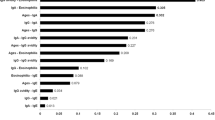Abstract
Toxocara canis is a common parasite in puppies. The danger to human health has not been properly established. We estimated the current incidence of this pathogen in two western districts of France, Loire-Atlantique and Maine et Loire. Blood samples from 1836 eosino-philic patients were collected and tested by an enzyme-linked immunosorbent assay (ELISA) excretory-secretoryToxocara antigen test. We obtained positive results in 22% of the cases and highly positive results in 7%. The ELISA data seemed to be age-dependent, with older patients having more positive results (P<0.0001). The interlaboratory distribution of positive test results was statistically significantly different (P<0.0001), suggesting regional sources. The main clinical expressions of toxocariasis were: asthenia, gastric pain, and pulmonary disease. Individual and collective surveys of this zoonotic disease need to be carried out.
Similar content being viewed by others
References
Barriga OO (1988) A critical look at the importance, prevalence and control of toxocariasis and the possibilities of immunological control. Vet Parasitol 29: 195–284
Baverel P (1993) Le marché des quatre pattes. Le Monde 6 April: 25, 28
Beaver PC, Snyder GH, Carrera GM (1952) Chronic eosinophilia due to visceral larva migrans. Pediatrics 9: 7–19
Benzacken L, Rickewaert M, Labalette P, Dutoit G, Ayadi A (1992) Toxocarose oculaire. A propos de deux observations de granulome périphérique. Coup Oeil 36: 51–56
Cauchie V, Chaillet P, Bigaignon G, Tomasi JP, Vervoort T (1990) Etude comparative des infections àToxocara en Belgique et autres pays. Acta Clin Belg 45: 227–239
Doury P, Pattin S, Dienot B (1977) Les rhumatismes parasitaires. Sem Hop 53: 1359–1363
Dromer C, Constantin A, Amar J, Caulier M, Billey T, Chamontin B, Magnaval JF, Fournie B (1994) Les formes rhumatologiques de la toxocarose. A propos de deux cas. Rev Rhum Mal Osteo-Articulaires (in press)
Fiore M di, Virga A, Usticano V, Rosa S di, Rini GB (1989) Anticorpi anti-Toxocara canis in sieri umani della Sicilia occidentale. Boll Ist Sierotera Milan 68: 93–96
Gautier C (1992) Toxocarose oculaire. Perspectives diagnostiques et thérapeutiques actuelles. A propos de trois observations. Thèse Médecine, Université de Nantes
Genchi C, Di Sacco B, Gatti S, Sangalli G, Scaglia M (1990) Epidemiology of human toxocariasis in northern Italy. Parasitologia 32: 313–319
Gillespie SH (1988) The epidemiology ofToxocara canis. Parasitol Today 4: 180–182
Glickman LT, Schantz PA, Grieve RB (1986) Toxocariosis. Immunodiagn Parasitol Dis 1: 201–231
Gueglio B, Marjolet M (1991) Les syndromes de Larva migrans toxocariens: une impasse parasitaire bien cachée. Bull Soc Fr Parasitol 9: 171–181
Gueglio B, Journel H, Smolik I, Pechereau A, Marjolet M (1991) Toxocarose oculaire: à propos d'un cas. Bull Soc Fr Parasitol 9: 59–63
Gueglio B, Picherot G, Martin G, Marjolet M (1993) Larva migrans et ostéochondrite. Association fortuite ou corrélation pathogénique (poster)? Soc Fr Parasitol 15 janvier Paris VI
Jacquier P, Gottsein B, Stingelin Y, Eckert J (1991) Immunodiagnosis of toxocariasis in human: evaluation of a new enzymelinked immunosorbent assay kit. J Clin Microbiol 29: 1831–1835
Kimming P, Naser K, Frank W (1991) Seroepidemioligische Untersuchungen zur Toxokariasis des Menschen. Zentralbl Bakteriol Mikrobiol Hyg [A] 191: 406–422
Leewan W, Cano MR, Pince KJ, Green RL (1991) Echographic characteristics of ocular toxocariasis. Ophthalmology 98: 28–32
Loiseau C (1991) Point actuel sur la toxocarose humaine: bilan d'une étude sérologique. Thèse Médecine, Université de Nantes
Magnaval JF (1987) Eléments nouveaux dans la sémiologie des “Larva migrans” viscérales. Presse Med 16: 151–154
Magnaval JF, Baixench MT (1994)Toxocara and toxocariasis: clinical, epidemiological and molecular perspectives. Institute of Biology/British Society for Parasitology, London (in press)
Magnaval JF, Marchesseau P, Larrouy G (1983) Les syndromes de “Larva migrans” viscérale ascaridienne dans la région Midi-Pyrénées: à propos de 48 observations. Bull Soc Pathol Exot Filiales 76: 69–75
Magnaval JF, Fabre R, Maurieres P, Charlet JP, Larrad B de (1991) Application of the Western blotting procedure for the immunodiagnosis of human toxocariasis. Parasitol Res 77: 697–702
Nagakura K, Tachibana H, Kaneda Y, Kato Y (1989) Toxocariasis possibly caused by ingesting raw chicken. J Infect Dis 160: 735–736
Nicholas WL, Stewart AC, Walker JC (1986) Toxocariasis: a serological survey of blood donors in the Australian Capital Territory together with observations on the risks of infection. Trans R Soc Trop Med Hyg 80: 217–221
Petithory JC, Ardoin F (1990) Prévalence en France et en Italie deToxocara canis et autres helminthes chez le chien en 1987–1989. Bull Soc Fr Parasitol 8: 257–266
Petithory JC, Liotet S, Chameil C, Moisan F, Beddok A, Batellier L, Brumpt LC (1990) Le syndrome de Larva migrans oculaire. Rev Fr Lab 18: 69–80
Portus M, Riera C, Prats G (1989) A serological survey of toxocariasis in patients and healthy donors in Barcelona, Spain. Eur J Epidemiol 5: 224–227
Romeu J, Roig J, Bada JL, Riera C, Munoz C (1991) Adult human toxocariasis acquired by eating raw snails. J Infect Dis 164: 438
Savigny de DH (1975) In vitro maintenance ofToxocara canis larvae and a simple method for the production ofToxocara ES antigen for use in serodiagnostic tests for visceral larva migrans. J Parasitol 61: 781–782
Scaglia M, Gatti S, Sangalli G, Manfredi MT, Vigano T, Bruno A, Genchi C (1988)Toxocara spp infection: seroepidemiological survey in blood donors and evaluation of risk factors. G Mal Infett Parasit 40: 915–920
Taylor MRH, Keane CT, O'Connor P, Mulvihill E, Holland C (1988) The expanded spectrum of toxocaral disease. Lancet II: 692–694
Wilder HC (1950) Nematode endophthalmitis. Trans Am Acad Ophthalmol Otolaryngol 155: 99–109
Author information
Authors and Affiliations
Rights and permissions
About this article
Cite this article
Gueglio, B., de Gentile, L., Nguyen, J.M. et al. Epidemiologic approach to human toxocariasis in western France. Parasitol Res 80, 531–536 (1994). https://doi.org/10.1007/BF00932703
Received:
Accepted:
Issue Date:
DOI: https://doi.org/10.1007/BF00932703



